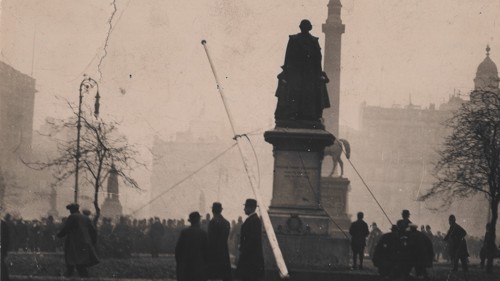The Battle of George Square - Times Past

In partnership with the Glasgow Times, our archivists are exploring Glasgow's fascinating history. This week, Nerys Tunnicliffe writes about the ‘Battle of George Square’ or ‘Bloody Friday’ that took place in January 1919.
Often depicted as tanks storming crowds in the streets to quell revolution, the truth about the Battle of George Square is less explosive, as papers from the Glasgow Trade Council collection held at the City Archives show. The tanks arrived days after the ‘battle’, and the protestors were largely demonstrating for improved conditions for Glasgow’s working class, rather than to take over the government.
The end of World War One brought relief, but there were growing tensions in Britain too. Thousands of returning soldiers needed new employment. At the same time munition factories closed leaving scores of industrial workers without a job. The Clyde Worker’s Committee (CWC) (whose members included prominent socialists such as William Gallacher, David Kirkwood and John MacLean), the Glasgow Trades Council, and other unions campaigned for a reduced 40 hour working week for engineers, to allow for more workers to be employed, as opposed to the 47 hour week previously agreed to. Engineering firms already struggling with reduced profits rebuffed any suggestion of reduced hours. Their workers responded with strike action. The strikes spread in a wave of protest to other industries such as shipbuilding and mining.
The ’40 hours strikes’ as they became to be known, startled a worried government in London desperate to avoid the unrest spreading elsewhere. Talks were held attempting to diffuse the situation between the Lord Provost of Glasgow and Glasgow strike leaders. The Lord Provost agreed to send a telegram to London outlining the workers’ demands. On the 31st January around 70,000 workers and their families took to Glasgow’s streets, marching to George Square to hear the government’s response to the telegram. The large crowd gathered outside the City Chambers.
Police forcefully attempted to clear the route for the trams around the square, making baton charges into the crowd. A map showing the tram routes at George Square was later drawn up as evidence of the troublesome disruption caused by the large volume of strikers. The riled crowds responded by throwing bottles and stones at police and a riot erupted. Even the strike leaders were caught up in the violence, with David Kirkwood being knocked down by police. Tensions continued throughout the following days, with soldiers and tanks deployed to Glasgow
Kirkwood, William Gallacher, Emmanuel Shinwell (chairman of Glasgow Trades Council) and others were arrested for incitement. The Glasgow Trades Council vigorously defended them, sending petitions to the Secretary State for Scotland, raising funds for legal fees and obtaining photographs from The Bulletin to show their leaders being injured in the riots. Although others were later acquitted, Gallacher and Shinwell were found guilty and served brief prison sentences.
The day’s events left a strong legacy. Rather than being discouraged, many of those involved like Shinwell were spurred to successfully pursue careers as MPs. Throughout the city there was a renewed political awareness with membership of the Independent Labour Party increasing, and the demand for better working and living conditions became signature of future Glasgow politics.

